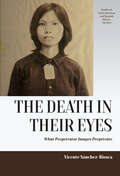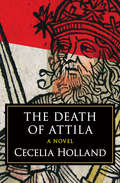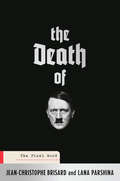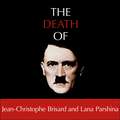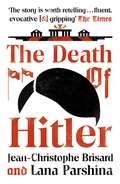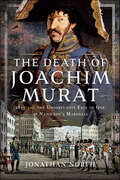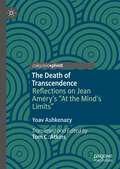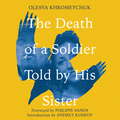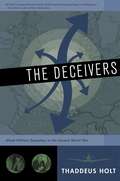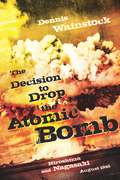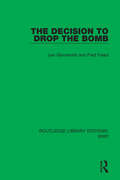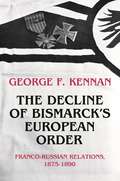- Table View
- List View
The Death in their Eyes: What Perpetrator Images Perpetrate (Studies in Latin American and Spanish History #12)
by Vicente Sánchez-BioscaImages that embody the point of view of the perpetrators of violent crimes, or their accomplices, force us to look at the pain of victims through the eyes of those who caused it. Accompanied by over sixty visuals of historically infamous violence, The Death in their Eyes goes beyond the visible aspects of images to reveal what has been left outside of the frame. Covering human abuse and humiliation at Abu Ghraib, the Auschwitz Album, religious desecration during the Spanish Civil War, an unfinished Nazi propaganda film made at the Warsaw Ghetto in the spring of 1942, and detainees at the S-21 torture center in Cambodia under the Khmer Rouge, this volume proposes a rigorous new methodology for analyzing perpetrator images, in photography and film, that continue to be used and re-appropriated in today’s media. Content warning: This book contains images of victims of murder and torture which are essential to the author’s analysis.
The Death of Attila: A Novel
by Cecelia HollandIn The Death of Attila, the great Hun leader dominates the late Roman world; in his shadow, a Hun warrior and a German princeling form a fragile comradeship. When Attila dies, the world around them crumbles, and the two men face terrible choices.
The Death of Ben Linder: The Story of a North American in Sandinista Nicaragua
by Joan KruckewittIn 1987, the death of Ben Linder, the first American killed by President Reagan's "freedom fighters" -- the U.S.-backed Nicaraguan Contras -- ignited a firestorm of protest and debate. In this landmark first biography of Linder, investigative journalist Joan Kruckewitt tells his story. In the summer of 1983, a 23-year-old American named Ben Linder arrived in Managua with a unicycle and a newly earned degree in engineering. In 1986, Linder moved from Managua to El Cuá, a village in the Nicaraguan war zone, where he helped form a team to build a hydroplant to bring electricity to the town. He was ambushed and killed by the Contras the following year while surveying a stream for a possible hydroplant. In 1993, Kruckewitt traveled to the Nicaraguan mountains to investigate Linder's death. In July 1995. she finally located and interviewed one of the men who killed Ben Linder, a story that became the basis for a New Yorker feature on Linder's death. Linder's story is a portrait of one idealist who died for his beliefs, as well as a picture of a failed foreign policy, vividly exposing the true dimensions of a war that forever marked the lives of both Nicaraguans and Americans.
The Death of Hitler's War Machine: The Final Destruction of the Wehrmacht
by Samuel W. Mitcham Jr.It was the endgame for Hitler's Reich.In the winter of 1944–45, Germany staked everything on its surprise campaign in the Ardennes, the &“Battle of the Bulge.&” But when American and Allied forces recovered from their initial shock, the German forces were left fighting for their very survival—especially on the Eastern Front, where the Soviet army was intent on matching, or even surpassing, Nazi atrocities.At the mercy of the Fuehrer, who refused to acknowledge reality and forbade German retreats, the Wehrmacht was slowly annihilated in horrific battles that have rarely been adequately covered in histories of the Second World War—especially the brutal Soviet siege of Budapest, which became known as the &“Stalingrad of the Waffen-SS.&”Capping a career that has produced more than forty books, Dr. Samuel W. Mitcham now tells the extraordinary tale of how Hitler&’s once-dreaded war machine came to a cataclysmic end, from the Battle of the Bulge in December 1944 to the German surrender in May 1945.Making use of German wartime papers and memoirs—some rarely seen in English-language sources—Mitcham&’s sweeping narrative deserves a place on the shelf of every student of World War II.
The Death of Hitler: The Final Word
by Jean-Christophe Brisard Lana ParshinaOn April 30, 1945, Hitler committed suicide in his bunker as the Red Army closed in on Berlin. Within four days the Soviets had recovered his body. But the truth about what the Russian secret services found was hidden from history, when, three months later, Stalin officially declared to Truman and Churchill that Hitler was still alive and had escaped abroad. Reckless rumors about what really happened to Hitler began to spread like wildfire and, even today, they have not been put to rest. Until now.In 2017, after two years of painstaking negotiations with the Russian authorities, award-winning investigative journalists Jean-Christophe Brisard and Lana Parshina gained access to confidential Soviet files that finally revealed the truth behind the incredible hunt for Hitler's body.Their investigation includes new eyewitness accounts of Hitler's final days, exclusive photographic evidence and interrogation records, and exhaustive research into the power struggle that ensued between Soviet, British, and American intelligence services. And for the first time since the end of World War II, official, cutting-edge forensic tests have been completed on the human remains recovered from the bunker graves--a piece of skull with traces of a lethal bullet, a fragment of bone, and teeth.In The Death of Hitler--written as thrillingly as any spy novel--Brisard and Parshina debunk all previous conspiracy theories about the death of the Führer. With breathtaking precision and immediacy they penetrate one of the most powerful and controversial secret services to take readers inside Hitler's bunker in its last hours--and solve the most notorious cold case in history.
The Death of Hitler: The Final Word on the Ultimate Cold Case: The Search for Hitler's Body
by Jean-Christophe Brisard Lana ParshinaA dramatic and revelatory new account of the final days in Hitler's bunker, based on new access to previously unseen Soviet archives, previously unseen materials, and cutting edge forensics.After two years of nonstop negotiations with the Russian authorities, Jean-Christophe Brisard and Lana Parshina were granted access to secret files detailing the Soviets' incredible hunt to recover Hitler's body: the layout of the bunker, plans for escaping, eyewitness accounts of the Führer's final days, and human remains-a bit of skull with traces of the lethal bullet and a fragment of jaw bone. For the first time, the skull, teeth and other elements were analysed by a medical examiner with cutting edge forensics equipment. The authors use these never before seen documents and research to reconstruct the events in fascinating new detail.(P)2018 Hodder & Stoughton Limited
The Death of Hitler: The Final Word on the Ultimate Cold Case: The Search for Hitler’s Body
by Jean-Christophe Brisard Lana ParshinaAfter two years of nonstop negotiations with the Russian authorities, Jean-Christophe Brisard and Lana Parshina were granted access to secret files detailing the Soviets' incredible hunt to recover Hitler's body: the layout of the bunker, plans for escaping, eyewitness accounts of the Führer's final days, and human remains-a bit of skull with traces of the lethal bullet and a fragment of jaw bone. For the first time, the skull, teeth and other elements were analysed by a medical examiner with cutting edge forensics equipment. The authors use these never before seen documents and research to reconstruct the events in fascinating new detail.
The Death of Hitler: The Full Story with New Evidence from Secret Russian Archives
by Peter Watson Ada Petrova"Revealing and well-written. . . . A significant book."--Houston Chronicle It is one of the most enduring mysteries of the twentieth century: how, exactly, Adolf Hitler died and what happened to his remains. With access to the Russians' Hitler Archive, this book reveals not only what happened after the Russians captured Hitler's bunker but also why the Soviets felt the details of his death had to be suppressed.
The Death of Joachim Murat: 1815 and the Unfortunate Fate of One of Napoleon's Marshals
by Jonathan NorthThe only English-language book on the fall and death of Joachim Murat and the final act in the drama of the Napoleonic Wars. Joachim Murat, son of an innkeeper, had won his spurs as Napoleon’s finest cavalry general and then won his throne when, in 1808, Napoleon appointed him king of Naples. He loyally ran this strategic Italian kingdom with his wife, Napoleon’s sister Caroline, until, in 1814, with Napoleon beaten and in retreat towards ruin and exile, the royal couple chose to betray their imperial relation and dramatically switched sides. This notorious betrayal won them temporary respite, but just a year later Murat engineered his own dramatic fall. A series of blunders took the cavalier king from thinking he had secured his dynasty to fleeing his kingdom. His native France did not welcome him, initially because Napoleon had not forgiven him, then, after Napoleon’s fall following Waterloo, because the restored Bourbons were offering a reward for Murat’s head. Fleeing again, fate brought him to Corsica where, welcomed at last, Murat turned to plotting the reversal in his fortunes he so felt he deserved. Murat soon resolved to bet everything on a hare-brained plan to return to Naples as a conquering hero and king. His aim was to take a small band of followers, land near his capital, organise regime change and reclaim his throne. In September 1815, he set off and what happened next forms the core of this part-tragic, part-ridiculous story and a lesson in how not to stage a coup. Just five days after landing in Calabria, King Joachim was hauled before a firing squad and executed. There is a fine line in history between a fool and a hero. Had Murat succeeded then he would be lauded as daringly heroic but, alas, he failed, and his final adventure has been consigned to oblivion. This is unfortunate as the fall of Joachim Murat is the final act of the Napoleonic Wars in Europe as well as being a dramatic story in its own right. Based on research in the archives of Paris and Naples, Jonathan North’s book aims to throw light on the fate of the mightily fallen Murat and restore some history to a tale that, until now, lay smothered under two centuries of fable and neglect.
The Death of Santini
by Pat ConroyIn this powerful and intimate memoir, the beloved bestselling author of The Prince of Tides and his father, the inspiration for The Great Santini, find some common ground at long last.Pat Conroy's father, Donald Patrick Conroy, was a towering figure in his son's life. The Marine Corps fighter pilot was often brutal, cruel, and violent; as Pat says, "I hated my father long before I knew there was an English word for 'hate.'" As the oldest of seven children who were dragged from military base to military base across the South, Pat bore witness to the toll his father's behavior took on his siblings, and especially on his mother, Peg. She was Pat's lifeline to a better world--that of books and culture. But eventually, despite repeated confrontations with his father, Pat managed to claw his way toward a life he could have only imagined as a child. Pat's great success as a writer has always been intimately linked with the exploration of his family history. While the publication of The Great Santini brought Pat much acclaim, the rift it caused with his father brought even more attention. Their long-simmering conflict burst into the open, fracturing an already battered family. But as Pat tenderly chronicles here, even the oldest of wounds can heal. In the final years of Don Conroy's life, he and his son reached a rapprochement of sorts. Quite unexpectedly, the Santini who had freely doled out physical abuse to his wife and children refocused his ire on those who had turned on Pat over the years. He defended his son's honor. The Death of Santini is at once a heart-wrenching account of personal and family struggle and a poignant lesson in how the ties of blood can both strangle and offer succor. It is an act of reckoning, an exorcism of demons, but one whose ultimate conclusion is that love can soften even the meanest of men, lending significance to one of the most-often quoted lines from Pat's bestselling novel The Prince of Tides: "In families there are no crimes beyond forgiveness."
The Death of Santini: The Story of a Father and His Son
by Pat ConroyNEW YORK TIMES BESTSELLER * Look for special features inside. Join the Random House Reader's Circle for author chats and more. Pat Conroy's great success as a writer has always been intimately linked with the exploration of his family history. As the oldest of seven children who were dragged from military base to military base across the South, Pat bore witness to the often cruel and violent behavior of his father, Marine Corps fighter pilot Donald Patrick Conroy. While the publication of The Great Santini brought Pat much acclaim, the rift it caused brought even more attention, fracturing an already battered family. But as Pat tenderly chronicles here, even the oldest of wounds can heal. In the final years of Don Conroy's life, the Santini unexpectedly refocused his ire to defend his son's honor. The Death of Santini is a heart-wrenching act of reckoning whose ultimate conclusion is that love can soften even the meanest of men, lending significance to the oft-quoted line from Pat's novel The Prince of Tides: "In families there are no crimes beyond forgiveness." Praise for The Death of Santini "A brilliant storyteller, a master of sarcasm, and a hallucinatory stylist whose obsession with the impress of the past on the present binds him to Southern literary tradition."--The Boston Globe "A painful, lyrical, addictive read that [Pat Conroy's] fans won't want to miss."--People "Conroy's conviction pulls you fleetly through the book, as does the potency of his bond with his family, no matter their sins."--The New York Times Book Review "Vital, large-hearted and often raucously funny."--The Washington Post "Conroy writes athletically and beautifully, slicing through painful memories like a point guard splitting the defense."--Minneapolis Star TribuneFrom the Trade Paperback edition.
The Death of Transcendence: Reflections on Jean Améry’s “At the Mind’s Limits”
by Yoav AshkenazyThe Death of Transcendence presents a clear and compelling close reading and interpretation of the five essays included in Jean Améry’s At the Mind’s Limits, describing them as one continuous and progressing argument on the possibility of human society in the wake of the Holocaust. Through the thought of Ludwig Wittgenstein, Iris Murdoch, J.M. Bernstein and, Charles Taylor, Ashkenazy uncovers the importance and significance of such concepts as transcendence, lose, self, other, love, and home for establishing and maintaining a human life and world, and recovering it, should it be lost. Written with both clarity and academic rigour, this book offers novel ideas, firmly grounded in existing philosophical literature, and is intended for both professional scholars and general readers of Améry.
The Death of a Soldier Told by His Sister
by Olesya KhromeychukA moving and thought-provoking story of loss and war from the Director of the Ukrainian institute, told in a powerful blend of memoir and essay***'Elegantly written... packed with the sharpness of moments when a death suddenly becomes real' -TLS'If you want to understand Ukraine's determination to resist, Olesya Khromeychuk's book is essential.' -Paul Mason, author of How to Stop Fascism'Moving, intelligent, and brilliantly written.' -Anna Reid, author of Borderland: A Journey Through the History of UkraineWITH A FOREWORD BY PHILIPPE SANDS AND AN INTRODUCTION BY ANDREY KURKOV Killed by shrapnel as he served in the Ukrainian Armed Forces, Olesya Khromeychuk's brother Volodymyr died on the frontline in eastern Ukraine. As Olesya tries to come to terms with losing her brother, she also tries to process the Russian invasion of Ukraine: as an immigrant living far from the frontline, as a historian of war and how societies respond to them, and as a woman, a civilian, and a sister.In this timely blend of memoir and essay, Olesya Khromeychuk tells the story of her brother - the wiser older sibling, the artist and the soldier - and of his death. Deeply moving and thoughtful, The Death of a Soldier Told by His Sister picks apart the ways political violence shapes everyone and everything it touches and depicts with extraordinary intimacy the singular and complicated bond between a brother and sister. Olesya's vivid writing is a personal and powerful commitment to honesty in life, in death and in memory.'Soon before he died, my brother said he had become a warrior. Why would a thinker, an artist, wish to become a soldier? Perhaps I didn't appreciate what it meant to be a thinker and an artist, or, maybe, what it meant to be a soldier.''In vivid, intimate prose and with unflinching honesty, Olesya Khromeychuk introduces us to the brother she lost in the war and found in her grief.' -Dr Rory Finnin, University of Cambridge'I admire a book that invites me to grapple with knotty questions. Olesya Khromeychuk has written such a book - beautifully.' - Professor Cynthia Enloe, author of Nimo's War
The Death of a Soldier Told by His Sister
by Olesya KhromeychukWITH A FOREWORD BY PHILIPPE SANDS AND AN INTRODUCTION BY ANDREY KURKOV'If you read only one book about the war, this is the one to read.' -Henry Marsh, author of Do No Harm'Unforgettable. An immediate history of a cruel war and a personal chronicle of unbearable loss' -Simon Sebag-Montefiore, author of The WorldKilled by shrapnel as he served in the Ukrainian Armed Forces, Olesya Khromeychuk's brother Volodymyr died on the frontline in eastern Ukraine. As Khromeychuk tries to come to terms with losing her brother, she also tries to process the Russian invasion of Ukraine: as a historian of war, as a woman and as a sister.In a thoughtful blend of memoir and essay, Olesya Khromeychuk tells the story of her brother - and of Ukraine. Beautifully written and giving unique, poignant insight into the lives of those affected, it is an urgent act of resistance against the dehumanising cruelty of war.'If you want to understand Ukraine's determination to resist, Olesya Khromeychuk's book is essential.' -Paul Mason, author of How to Stop Fascism[A] tender and courageous book... Khromeychuk's clear-sighted prose expresses the pain that thousands, even millions, have felt in every conflict, past and present. -The Literary Review Magazine'A touching and brilliantly written account about grief, and also about strength. I read it in one night.' -Olia Hercules
The Debutante: A Novel
by Kathleen TessaroA brilliant, unforgettable novel by the New York Times bestselling author of The Perfume Collector.Can the secrets of one woman's past change another woman's future?Cate Albion is a gifted young artist at a crossroads in her life. Looking to escape New York for the summer, she takes a job in her aunt's London auction house and is soon sent on assignment to the English countryside to value the contents of Endsleigh House, the once gracious but now crumbling estate of a former Jazz Age socialite. There, hidden in the back of a dusty bookshelf, Cate discovers an old shoebox, and inside, a peculiar assortment of objects, including an exquisite pair of 1930s dancing shoes; a faded photograph of a handsome young sailor, and a rare Tiffany pearl and emerald bracelet.Intrigued, Cate sets out to learn more about the box and its contents, and becomes immersed in the mystery of its owner, Diana “Baby” Blythe, the younger of the infamous, glamorous Blythe sisters. Bright, beautiful, and reckless, Baby was the most famous debutante of her generation . . . until she suddenly disappeared entirely from view. As a shocking tale of love and betrayal begins to unravel, Cate finds herself being drawn deeper into Baby's tragic life story—one that will force Cate to confront some dark truths about her own choices.
The Deceivers: Allied Military Deception in the Second World War
by Thaddeus HoltIn World War II, the Allies employed unprecedented methods and practiced the most successful military deception ever seen, meticulously feeding misinformation to Axis intelligence to lead Axis commanders into erroneous action. Thaddeus Holt's elegantly written and comprehensive book is the first to tell the full story behind these operations. Exactly how the Allies engaged in strategic deception has remained secret for decades. Now, with the help of newly declassified material, Holt reveals this secret to the world in a riveting work of historical scholarship. Once the Americans joined the war in 1941, they had much to learn from their British counterparts, who had been honing their deception skills for years. As the war progressed, the British took charge of misinformation efforts in the European theater, while the Americans focused on the Pacific. The Deceivers takes readers from the early British achievements in the Middle East and Europe at the beginning of the war to the massive Allied success of D-Day, American victory in the Pacific theater, and the war's culmination on the brink of an invasion of Japan. Colonel John Bevan, who managed British deception operations from London, described the three essentials to strategic deception as good plans, double agents, and codebreaking, and The Deceivers covers each of these aspects in minute detail. Holt brings to life the little-known men, British and American, who ran Allied deception, such as Bevan, Dudley Clarke, Peter Fleming, Douglas Fairbanks, Jr., and Newman Smith. He tracks the development of deception techniques and tells the hitherto unknown story of double agent management and other deception through the American FBI and Joint Security Control. Full of fascinating sources and astounding revelations, The Deceivers is an indispensable volume and an unparalleled contribution to World War II literature.
The Decision to Disarm Germany: British Policy Towards Postwar German Disarmament, 1914-1919 (Routledge Revivals)
by Lorna S. JaffeOriginally published in 1985 The Decision to Disarm Germany offers a fresh approach to Britain’s First World War and Paris Peace Conference policy on the question of German military disarmament. It offers interpretations based on extensive research into unpublished records and private papers and provides important new conclusions about British policy. The book shows the interaction of domestic concerns and strategic considerations in the wartime development of British thinking on the issue of post-war German disarmament and in the post-Armistice formulation and implementation of Britain’s German disarmament policy. It establishes the crucial interrelationship in British thinking and policy between German disarmament and general disarmament. It also shows the interwar consequences of wartime attitudes and peace conference policy.
The Decision to Drop the Atomic Bomb
by Dennis D. WainstockIn 1945 Imperial Japan was making every effort to seek an honorable surrender while the United States was trying to decide whether or not to drop the atomic bomb. While the main focus remains on the political aspects of the decision President Harry Truman was about to make, the author also focuses on the logistics and military situation of the United States and Japan during the last year of the war. The Potsdam Conference plays a key role in the unfolding drama of the Imperial decisions that led to Japan's surrender.Dennis D. Wainstock teaches at Salem-Tieyko University in Salem, West Virginia.
The Decision to Drop the Bomb (Routledge Library Editions: WW2 #7)
by Len Giovannitti Fred FreedThis book, first published in 1967, examines the circumstances and events that led to the dropping of two atomic bombs on Japan, devastating Hiroshima and Nagasaki. The death of President Roosevelt three weeks before the end of the European war led to an incoming President, Truman, who had heard nothing of the project before taking office. He and his advisers had no precedents to guide them as they considered what to do, and withing their closely drawn circle there were genuine differences of opinion about the use of atomic weapons. This book traces the course of the discussions between the politicians and their technical advisers, the part played by personal relationships, and the attempt by some of the scientists to stop the bomb being used without warning. In addition, it supplies a thorough analysis of developments abroad, and in particular the situation in Japan. It shows that the debate in Washington and the atomic plants was careful and wide-ranging, and that issues are no less complex for being supremely important. The result is to provide both a study of decision-making and a valuable contribution to our understanding of the closing months of the Second World War.
The Decision to Use the Atomic Bomb
by Gar AlperovitzControversial in nature, this book demonstrates that the United States did not need to use the atomic bomb against Japan. Alperovitz criticizes one of the most hotly debated precursory events to the Cold War, an event that was largely responsible for the evolution of post-World War II American politics and culture.From the Trade Paperback edition.
The Decisive Campaigns of the Desert Air Force, 1942–1945
by Bryn EvansCompared to the RAF's Fighter and Bomber Commands, the Desert Air Force (DAF) is far less well known, yet its achievements were spectacular.DAF led the way in North Africa and Italy in pioneering new tactics in close Army-Air Force co-operation on the battlefield, DAF and Allied air forces gave Allied armies in North Africa and Italy a decisive cutting edge.While the Axis forces used the many rivers and mountains of Tunisia and Italy to slow the Allies' advance, DAF was there to provide that extra mobile firepower the artillery from the sky. They were the first multi-national air force, and the first to introduce air controllers in the front lines of the battlefield.With first-hand accounts by veteran airmen form Britain, Australia, Canada, New Zealand, South Africa and the USA, this book reveals the decisive victories with which DAF won the war over North Africa, the Mediterranean and Italy in 1942-45.
The Decisiveness Of Israeli Small-Unit Leadership On The Golan Heights In The 1973 Yom Kippur War
by Major Oakland MccullochThis study is an analysis of the decisiveness of Israeli small-unit leadership on the Golan Heights during the 1973 Yom Kippur War. What allowed the Israeli brigades on the Golan Heights to defeat an Arab coalition that launched a surprise attack with a force that vastly outnumbered the Israelis in men, tanks and artillery? The one advantage the Israelis had was the quality of leadership at the small-unit level. This study begins with a brief review of the strategic and operational situation in the Middle East in 1973. This includes background information on the Israeli and Arab forces facing each other on the Golan Heights and their plans for the defense and attack respectfully prior to the start of hostilities. The majority of the thesis discussion is concerned with the actual battle on the Golan Heights. It highlights the contributions that small-unit leadership made during the battle that allowed the vastly outnumbered IDF to destroy a massive Soviet-style Arab army. This portion of the study also looks at the experiences of those Israeli leaders involved in the fighting. The study then looks at leadership from the Israeli perspective. I define what leadership is and why it is important at the small-unit level. I take a close look at how the Israeli Defense Force (IDF) picks and trains its leaders and what role the Israeli Military Culture plays in that process. The conclusion of the thesis is that the IDF was able to fight and win even though surprised and vastly outnumbered due to the quality of leadership at the small-unit level. This lesson may prove to be important still today as the armies of the Western societies continue to get smaller even though they still face the threat of fighting the massive Soviet-style armies of the "Axis of Evil" for decades to come.
The Decline of Bismarck's European Order: Franco-Russian Relations 1875-1890
by George Frost KennanIn an attempt to discover some of the underlying origins of World War I, the eminent diplomat and writer George Kennan focuses on a small sector of offstage events to show how they affected the drama at large long before the war even began. In the introduction to his book George Kennan tells us, "I came to see World War I . . . as the great seminal catastrophe of this century--the event which . . . lay at the heart of the failure and decline of this Western civilization." But, he asks, who could help being struck by the contrast between this apocalyptic result and the "delirious euphoria" of the crowds on the streets of Europe at the outbreak of war in 1914! "Were we not," he suggests, "in the face of some monstrous miscalculation--some pervasive failure to read correctly the outward indicators of one's own situation?" It is from this perspective that Mr. Kennan launches a "micro-history" of the Franco-Russian relationship as far back as the 1870s in an effort to determine the motives that led people "to wander so blindly" into the horrors of the First World War.
The Decline of Bismarck’s European Order: Franco-Russian Relations, 1875-1890
by George F. KennanThe Franco-Russian alliance evolved more and more steadily into a long-term military alliance, an instrument of foreign policy that Kennan deplored as too rigid and unresponsive to a changing international situation.
The Decoys: A Tale of Three Atlantic Convoys, 1942
by Bernard EdwardsIn November 1942, Britain and America launched Operation TORCH, the ambitious invasion of French North Africa.To convey 70,000 troops and their equipment required 600 merchant ships crossing the U-boat infested North Atlantic. The need for their protection meant withdrawing escorts from the routine convoys. Amongst those left without adequate defence were RB 1 and SC 107, both eastbound from America, and SL 125, northbound from Freetown. All three were at sea at the same time as the TORCH convoys.
